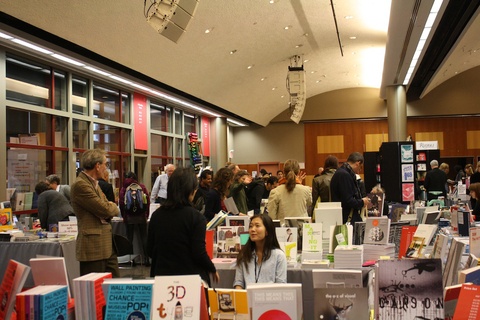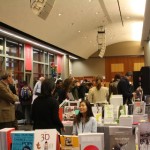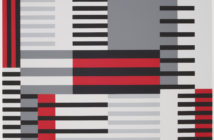The inaugural Designers and Books Fair was held from October 26—28 at the Fashion Institute of Technology in New York City. Based on the website DesignersAndBooks.com, the fair attempted to emulate the site’s focus on the relationship between designers and books. As is the nature of most fairs the products were priced to sell, with monograph hardcovers of Sophie Calle or Le Corbusier dotting the booths of big-name publishers. Among the obvious (Rizzoli, Phaidon, and MIT Press) were the inclusion of smaller book arts exhibitors who made the attempt to engage visitors in sharing their craft rather than selling a product. Society of Scribes had several calligraphers offering visitors to write your name in beautiful script or in Hebrew, which I could not refuse. And Paul Vogel, of the over 30-year old Vogel Bindery, demonstrated various techniques of bookbinding with the most delicate leather book covers.
Accompanying the book fair was an extensive program of panel talks covering various fields from fashion to bicycle to digital design. Though it seemed to wish to transcend this, I found that the fair and these panel talks became more interested in revenue-drivers rather than creating engaging discussions or community. Organizers charged for attendance to the panel talks — ranging from $25 to $35 for a ticket — which undermined both the diversity of the audience and the numbers in attendance.
One panel I attended that successfully managed to create an engaging dialogue was "Chinese Design Culture Now," featuring industrial designer Eric Chan, author of recently published China’s Design Revolution, Lorraine Justice, architect and interior designer Calvin Tsai, Design Director of the Beijing 2008 Olympics and Dean of School of Design at China Central Academy of Fine Arts Min Wang, and Dean of the School of Design at Jiangnan University Xiangyang Xin. The panel discussion was moderated by Susan Szenasy, editor-in-chief of Metropolis magazine.
The panel was a didactic commentary on the state and future of Chinese design, its cultural context and the differences in design culture from the West. As the talk progressed I noticed a two-fold disposition to the discussion and the panel members. On one hand were the more Westernized, and as Calvin Tsai aptly termed it, ‘faux Chinese’ designers comprising of himself and Chan. And on the other were Wang and Xin who seemed more rooted within the context of China. Beyond this, were two frameworks in which Chinese design was discussed: Chan and Tsai spoke on Chinese design in terms of aesthetics and consumerism, while Wang and Xin addressed design within academia. Despite diverse outlooks on Chinese design whether consumerist or academic — they all agreed on a central belief: that design is the hot topic in China now and it is just the beginning.
Eric Chan, industrial designer and founder of EcoDesign NYC talked about the uniqueness of Chinese design and its roots in traditional Chinese aesthetics. He approached Chinese design through comparisons with Western art. For example, the West views time and art in sequences while China expresses time and art through cycles.
Drawing inspiration from Chinese traditional ideology and materials, such as yin and yang, harmony of man and nature, and the bamboo medium, Chan has been successful in designing products that highly appeal to the Chinese market. At the end of his presentation, he returned to the idea of cyclical time in Chinese tradition and declared the present as the beginning of a new cycle — a time where Chinese consumers are not only ready, but are also yearning for products that center on finer design.
Lorraine Justice talked about her epiphanies as a Westerner entering the Chinese design scene and how she has changed as a designer after her experiences in China. She talked about the history of product design in China and how, despite China’s economic growth and technological advancements, products have not really changed much. Using examples of the tea mug and the thermos, she addressed product differentiation and continuity in China. She also brought up examples of Chinese design students, which was an appropriate introduction to Wang and Xin who would later address academics in design in China.
Calvin Tsao discussed the aesthetics of Chinese design in a strongly utilitarian society and the context of which the Chinese people view beauty. He brought up examples of humble totalitarian objects in Chinese society—objects which effectively combine the essential and the delightful aspects of design, without even being aware of it. Tsao showed photographs of a construction worker’s dorm room. The worker, unaware of the aesthetics of design, had plastered an array of wallpaper on the walls and built a makeshift desk and television table. This was an example of the long traditional in China of how the individual has learned to design their world in very personal, symbolic, and yet functional terms.
Min Wang titled his presentation "From Made in China to Designed in China" and gave the audience several statistics of the rise of design in China over the decades. Wang compared the number of design programs, students, and agencies from the time he was a student — over 30 years ago — to now. He told of how Design is the second most popular major in China (after Computer Science). He firmly expressed the need for a high level of education for these young designers and to transform China from a nation where products are made to one where they are designed.
Xiangyang Xin approached his presentation through a chronological view of China’s history. He talked about how before the Tang dynasty, China was China’s China; after the end of the Tang, China became Asia’s China; however, since the 1980s, China has become a global China. He described China’s present state as a "moment of confusion." A moment where Chinese designers have to balance their designs between traditional and new, communist and capitalist. Beside education, he addressed the need for organizational design and to design of society into creative and inventive organizations. What Xin meant by that remained unclear but he did reiterate Eric Chan’s claim that the present, this "moment of confusion," is a point of beginning.
Following the presentation was a discussion among the speakers led by Susan Szenasy, which was incredibly disappointing. I understand Designers and Books’ decision to have Szenasy moderate the panel. As an American designer discovering Chinese Design for the first time, her approach and perspective was wholly relatable and acceptable. Nonetheless, her knowledge of China and its design scene was rather naïve and I would think that choosing a moderator with basic knowledge of the subject would have been much more effective. Also, I am aware of the fact that I am one of the few audience members who is acquainted and informed on the subject. My chief issue with the discussion was that amount of time spent addressing the sole issue of pollution and environmental problems in China. There are many layers and aspects that make up Chinese design culture today; therefore, to spend so much time on environmental issues was a true disservice. Furthermore, Szenasy seemed more intent on asserting her personal politics and the uninformed view that the responsibility of solving China’s environmental situation rests on China alone and is not being addressed. This is far from the case. And as the speakers reiterated throughout the discussion, China’s environmental problems are a key issue to the Chinese government; but above that, these problems are a global problem caused by a consumerist culture. Towards the end, there was some dialogue on government’s role and education; however, it was quite brief and at the expense of the audience, whose questions were redirected to a meet-and-greet with the speakers in the lobby. Time ran out before the audience could even participate.
Although the Designers and Books’s inaugural fair was a commendable effort to cohesively reflect on the relationship between the design and publishing worlds, I hope that the fair and program of talks will in the future strive, as this panel did, to more wholly raise important questions about the future of book design and more accurately reflect the intentions of the website.
- The Designers and Books Fair
- #DBFair in Dwell Magazine






